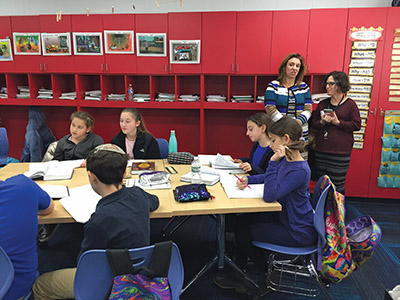
Five years ago, The Moriah School received a BOLD (Blended and Online Learning in Day Schools) grant to institute an entirely new instructional model comprising individualized teaching with technology-based learning and online assessment tools. While the grant lasted only three years, the school now considers itself in “year five” of its new model, which it is constantly tweaking to both optimize student performance and provide sufficient support to teachers. Last week, Moriah opened its doors to educators from other schools, to share what it has learned. Eleven educators joined from Hebrew Academy of Nassau County, Yeshiva Shaarei Tzion, Jewish Educational Center, Kushner, Golda Och Academy and Gottesman RTW Academy. This is the second time that Moriah has offered an “educator’s experience.”
To build their new model, the staff and administration at Moriah worked together to combine adaptive digital learning tools with individualized instruction to students who need it, using rotations. The teacher works face-to-face with almost every student, almost every day. Concurrently, Moriah offers instruction for students with a range of special needs inside the same classrooms through its Gesher Yehuda Program, which provides a 1:1 teacher-to-student ratio and allows for the students to benefit from and thrive in a mainstream classroom as much as possible.
Many of the teachers who spoke to the educator’s experience attendees addressed how much more impactful they feel their teaching has become under the new model. However, development of the program certainly involved a degree of trial and error and the process was not without hiccups. For example, “In year one, there was tension between the administration and teachers, but in the middle of the year a light bulb went off; we needed planning time for the teams to bounce ideas off of and plan lessons together,” said Lauren Adler, technology coordinator for Moriah’s lower school. She explained that all the teachers now work in teams with administrators and spend a half an hour together each morning working on lesson planning. An outgrowth of increased administrator/teacher interaction has been personalized professional development programming.
While the school uses rotational models that might look different in each classroom (for general studies, Hebrew language and Limudei Kodesh) and different technology programs are applied based on grade level and the subjects being taught, there is commonality throughout the school with a purchased program, Responsive Classroom. This program creates a commonality of language throughout the school and seeks to create a culture of calmness so that students know what to expect in each classroom; if an issue of concern comes up, the students and teachers have a unified way to respond and address concerns right away.
Students have also become more confident in asking for the types of projects in which they have interest. The STEM (Science, Technology, Engineering and Mathematics) program has really shone as part of this model. Moriah students use Scratch Junior in grades one and two, Scratch in grades three through five, and Lego Robotics in fifth grade and beyond. “It starts out with the kids following the book, but they then go off on their own,” said Sharon Sherman, who manages the STEM lab at Moriah. “They feed off each other and work on problem-solving and programming. This is free learning; I am not directing them,” she explained. “They are driven by interest and curiosity. Failures are the successes in STEM. It’s a risk-free environment.”
With their earlier, more traditional education model, “We were teaching most of the kids most of the time; now we’re teaching every kid, all of the time,” said Adler. “Being able to educate all the kids on their level, with what they need when they need it, and being able to differentiate curriculum in a way so that every single child in the classroom can meet success, to see a light bulb in 24 heads, not just five… This changes everything,” said Adler. “Every day the teacher went home and felt like they had a successful day. Students went home and felt they could attack that homework, because the way they were taught spoke to them,” she added.
Moriah Head of School Rabbi Daniel Alter, whose previous school, the Denver Academy of Torah, was also a recipient of the BOLD grant five years ago, talked about how the grant has enabled the school as a community to become more adaptive, and how the board and parent body are also partners in this endeavor. One challenge that was recently addressed by a parent was how to manage students who carry digital devices during school hours. The parent did research on how best to limit unrestricted online time in school, and Moriah ultimately purchased a smartphone lockdown device called YONDR. It provides locking pouches for students to place their device, which they can touch to an unlocking unit at the end of the school day for the bus ride home.
In addition to using adaptive digital tools, Moriah attributes its success to three other factors: its ability to translate real-time data to understand how students are doing, to the support its teachers have in lesson planning, and the fact that they actively work to assess students against national norms, to constantly make sure the students are performing as well as possible according to national averages.
Adler shared that many of the educators who attended Moriah’s educator’s experience are using some forms of differentiation in their classrooms, “but most schools that visited are just beginning their journey towards becoming blended and using personalized learning.”
By Elizabeth Kratz













